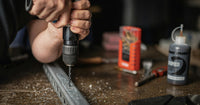If you're wondering how to fix a sagging wrought iron gate, you're not alone. This common issue often stems from worn hinges, loose posts, or the gate's weight over time. The good news? You don’t need to call a pro to fix it. With a little guidance (that’s where I come in), you can handle it yourself. I've dealt with this plenty of times, so in this guide, we're breaking it all down in the simplest way possible, just straightforward steps anyone can follow. Let’s get into it.
Identify the Cause
Check the gate post
Start by looking at the post the gate is attached to. Is it standing straight, or is it leaning to one side? Give it a little shake; if it moves, it’s probably loose in the ground or the concrete around it has cracked. A wobbly or tilted post can affect fixing a metal gate that has dropped, so take note of any movement or shifting. Also, check for rust or rot at the base if it's set in the ground.
Inspect the hinges
Take a close look at the hinges. Are the screws or bolts holding them in place tight, or do they look like they’ve started to pull out? Is there rust building up? Wiggle the gate and see if the hinges move too much; that’s a sign they might be worn or not holding properly. Hinges take on a lot of the gate's weight, so any small issue here can lead to sagging.
Examine the gate frame
Walk around the gate and look at the frame itself. Is it still straight, or do you see a bend, twist, or even a crack? Sometimes, just one corner starts to dip or one side looks lower than the other. If it's a wrought iron gate, check for rusted joints or broken welds.
This step is just about spotting the problem so you know exactly what needs fixing next.
Adjust or Replace Hinges
Tighten hinge bolts
Grab a wrench and check every bolt on the hinge plates. If any of them feel loose, tighten them up, but do it gradually. Over-tightening can strip the threads, especially if you're working with older gates. If the screws are spinning or not catching, that could mean the holes in the post or gate frame are worn out. In that case, you might need slightly larger screws or to fill and redrill the holes for a tighter fit.
Replace worn hinges
If the hinges are rusted through, bent, or just not holding the gate up like they used to, it’s best to replace them. Try to match the size and style of the old ones so they fit the existing holes. Otherwise, you’ll have to drill new ones. When installing new hinges, make sure they’re heavy-duty enough to carry the weight of your gate, especially if it’s a large driveway gate.
Adjust hinge position
Sometimes the hinges are fine, but they’re not sitting in the right place anymore. You’ll need to loosen the bolts and shift the hinge bracket slightly - usually a few millimeters up or down is enough to realign the gate. This part might take some trial and error. It helps to have someone hold the gate while you make adjustments. Just make sure everything is level before you tighten the bolts back up, or you’ll end up chasing the problem instead of fixing it.
Reinforce the Gate Frame
Add a diagonal brace
A sagging gate often just needs extra support across the frame, and that’s where a diagonal brace comes in. The brace should go from the top corner on the hinge side down to the bottom corner on the latch side. This helps shift the weight back toward the hinges and keeps the gate square. You can use a piece of metal flat bar or even a sturdy wooden board. Make sure it’s screwed in tightly at both ends, and that it fits snug against the gate frame. If it’s just loosely attached, it won’t do much. Don’t place the brace the other way around. It won’t help, and it could make things worse.
Use a turnbuckle and cable
If you prefer something adjustable, go with a turnbuckle and cable setup. You’ll need two eye bolts, a steel cable, and a turnbuckle. First, attach the eye bolts to the same corners you would with a brace: top hinge side and bottom latch side. Run the cable between them and thread the turnbuckle in the middle. Tightening the turnbuckle will pull the gate back into alignment. This method is great if the gate only needs a little tweaking, and it’s especially useful for lighter gates or temporary fixes. Just be careful not to over-tighten; you could bend the frame or pop the eye bolts loose.
Support the Gate Weight
Install a gate wheel
A gate wheel is a simple fix that takes the pressure off your hinges by helping support the weight of the gate. Before you install one, make sure the ground under the gate is fairly even. If the surface is too bumpy or sloped, the wheel might not roll properly and could even make the problem worse. If needed, level out the area with a shovel or add a bit of gravel or concrete where the wheel will travel.
To install it, first close the gate and mark the spot where the bottom edge hangs lowest. This is usually where the wheel should go. Most gate wheels come with a mounting bracket that you’ll screw or bolt into the bottom frame of the gate. Make sure the bracket is tight and sits flat against the frame. The wheel should touch the ground firmly but not lift the gate. It’s there to assist, not to hold the whole thing up. If the gate moves on uneven terrain, consider a spring-loaded gate wheel that adjusts to ground height as the gate opens and closes.
Address Post Issues
Stabilize leaning posts
If the gate post is leaning, that’s likely the root of your sagging problem. Start by digging around the base of the post, about 6 to 8 inches deep all the way around, until you can move it slightly. If the post is set in concrete and the concrete is cracked or loose, you’ll need to break it up and remove it completely.
Once the post is free, use a level to straighten it up. It’s best to have someone hold it in place while you prepare the new support. Pour fresh concrete into the hole, making sure it fills in evenly around the post. Use a level again to double-check that the post is perfectly vertical. Let the concrete cure for at least 24–48 hours before rehanging or adjusting the gate. If the post is set in soil instead of concrete, pack the dirt back in tightly or mix in gravel for better support, but keep in mind, this won’t be as sturdy long-term.
Final Checks
Test gate movement
Once you’ve made all your adjustments and fixes, don’t skip the final test, open and close the gate a few times. It should move smoothly, without dragging on the ground or catching anywhere. This is where you find out if everything you did actually worked. If the gate still sags or feels off, it’s better to catch it now than later. Sometimes a small tweak, like loosening a hinge slightly or adjusting the brace, can make all the difference.
Ensure latch alignment
Check the latch while the gate is closed. Does it line up with the post latch plate? If it’s even a little off, the gate won’t lock properly, and that kind of defeats the purpose. Misalignment here usually means the gate isn’t level or the post has shifted slightly. Don’t force it; forcing the latch closed can damage it or bend the frame. If it’s not lining up, go back and check your previous steps. This part matters because if the latch doesn’t work, you might have to redo everything. And no one wants to go through all that work twice.
Metal Gate Q&A: More Questions You Might Have
How often should I check or maintain my gate to prevent sagging?
At least twice a year is a good rule of thumb. Do a quick inspection every spring and fall: check the hinges, the post stability, and whether the gate still swings and latches properly. If your area gets a lot of rain, snow, or heat, you might want to check more often.
Is it better to weld a broken hinge or replace it entirely?
Yes, in most cases it’s better to replace it entirely. Welding can be a solid fix, but only if the rest of the hinge and gate frame are in great shape. If there’s rust or the metal around the break is thin, welding might not hold for long. Replacing the hinge is often easier, safer, and gives you a longer-lasting fix.
Will adding an automatic opener worsen a sagging gate?
Yes, it can. Automatic openers add weight and extra stress to the hinges and posts, especially when the gate opens and closes multiple times a day. If your gate is already sagging, adding a motor might make the problem worse or damage the opener itself. It’s best to fix the sagging first, then install the opener once everything is level and solid.
What type of gate is less likely to sag over time?
Lighter gates with strong, welded frames are less likely to sag. Aluminum gates or smaller steel gates with reinforced corners and proper diagonal bracing hold up well. Double gates that share the load across two posts are also more stable than wide, single-panel gates.
Conclusion
That wraps up everything you need to know about fixing a sagging or dropped metal gate. We went through all the common issues and the best ways to deal with them, step by step. If you’ve tried everything in this guide and your gate is still giving you trouble, it might be time to think about replacing some part, or in some cases, the whole gate. Sometimes wear and tear just goes too far. But with the right fix, most gates can be brought back to life without too much hassle. If you need help with the repairs or want to explore high-quality handrails, feel free to contact us here or browse our catalog for more options.









